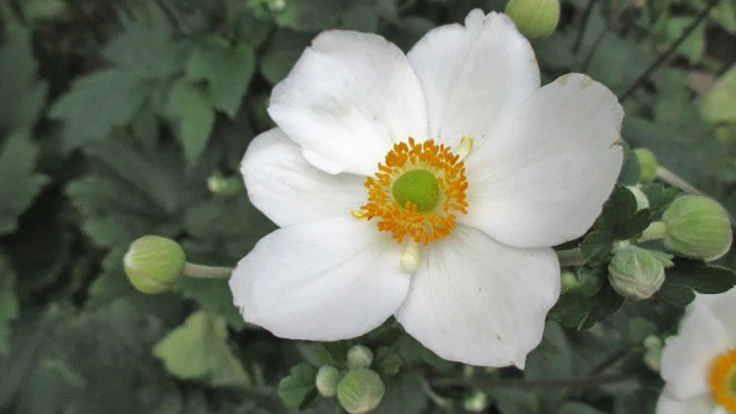
Anemone was found in China and other Asiatic countries as well as the Mediterranean region. The origins gave rise to the common name "Japanese anemone". "Windflower" is another name popularly applied to the plant. This anemone has existed in the English garden at the Royal Horticultural Society in Chadwick at least since 1848. Before then, many of the fall flowering anemone were a very light pink.
Ten years later, a fantastic new hybrid occurred in Verdun, France, in the Jobert Gardens and was named ‘Honorine Jobert’. Soon, this exciting discovery went to England and eventually to American gardens. It was a sought-after cultivar by the time of the American Civil War and since has become a classic perennial in gardens of the world. It is found in borders, cottage gardens, or in formal borders and continues to grow in popularity.
Plants are clump-forming and erect. The long wiry stems make the plant look airy and graceful. ‘Honorine Jobert’ attains heights of up to 4 feet although most of the time it is a 3-feet beauty.
Flowers are intense bright white with a green center surrounded by a corolla of yellow stamens. In late summer, 2” to 3” flowers of ‘Honorine Jobert’ explode from dainty pink, silvery buds into petaloid-shaped flowers. The striking flowers are enhanced by the uniquely attractive trifoliate dark green textural foliage that stays attractive from spring to fall.
The anemone is a very low-maintenance plant. It can be grown in sun or in partial shade. In warm climates it should definitely be in partial shade with protection from wind. Be aware to plant only in early spring or fall. In any location, the plant thrives in humus-rich soil that is well–drained but moisture retentive. It does not tolerate wet, poorly-draining soils in winter. In colder climates, mulch establishing plants. Soils should not be allowed to become dry. The foliage will burn in hot, dry locations. Eventually the spreading rhizomes will be happy to colonize your garden.
‘Honorine Jobert’ grows in USDA zones 4 to 8. It seems to flourish without insect or disease problems and deer do not seem to browse this plant. The best time to propagate is winter or spring. In winter they are usually propagated by root cuttings and in spring by division.
‘Honorine Jobert’ goes well with many other annuals and perennials. Since ‘Honorine Jobert’ flowers into autumn the bright white plant stands out in the landscape and provides accents to the deeper gold, orange, and red colors of the fall garden. They can be charming companion plants with hostas and ferns and countless annuals. Classic plants stand the test of time. This plant more than fills that requirement.
Correction: The article originally and incorrectly stated that this plant was named by the National Garden Bureau. They sent the information on the Perennial Plant Association's behalf. We apologize for this error.
Latest from Garden Center
- America in Bloom announces 2026 program launch and celebrates 25 years of growing vibrant communities
- AmericanHort launches HortCred to advance skills development in the green industry
- Oasis Grower Solutions announces new northeast territory sales manager
- Amanda Solliday named senior manager of Sustainabloom
- New McCarthy-Family Flowers Legacy Fund supports multi-generational retail florists
- Monrovia releases new retail program, Landscape Legends, to mark 100th anniversary
- USDA to conduct 2025 Organic Survey
- Save the date for the 78th Santa Barbara International Orchid Show





